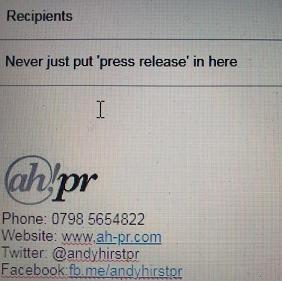These basic mistakes irritate busy news editors every day

News editors lead hectic working lives … so here are 5 golden rules as to what you shouldn’t do when submitting a press release to them.
They brief reporters, go to editorial meetings, write stories and deal with phone calls. The list goes on and on … and then there are the emails.
That’s where the press releases flood in and with dozens if not hundreds of emails to wade through every day the news editor makes a split second decision to either use or lose (delete) the press release.
So, remember these simple tips to boost the chances of your press release being published.
Rule 1: Never write 'press release' in the subject box. Ever.
Just about every email that comes in is, in effect, a press release yet even professional PR companies and public authority press officers still just put 'press release' in the subject line.
It means the chances of it being used are instantly diminished. That subject line is all important – it needs to grab the news editor’s attention and keep it long enough to keep that hovering finger away from delete.
Make it pertinent to that newspaper’s needs – one size doesn’t necessarily fit all in this game. If there’s an angle to that media organisation’s area it needs to boldly state it.
So a story about a company’s research into cancer, for example, should say instead of ‘press release’: Manchester company’s breakthrough in pioneering cancer research. That will be ideal for Manchester-based media but the city’s name isn’t needed in the subject line if the press release is sent further afield.
Rule 2: Don’t add the press release as an attachment. Paste the words straight into the body of the email. If there’s a word attachment it takes time to open it. The news editor needs to see immediately what it’s about and how long it is. It must be immediately visible.
Rule 3: Never just put a link to a website and a cryptic message such as ‘here’s our great new product’ and a direct link to your website. It’s lazy and news editors won't have the time or inclination to follow the link. If you can’t be bothered to submit a good press release why should they be bothered to waste valuable time trying to do your job for you?
Rule 4: Don’t send out a press release without getting someone else to look over it first for any obvious mistakes. No matter how many times you read it the eye can miss blatant errors. A Yorkshire restaurant was inviting journalists to try out its Christmas menu and the first line of the press release stated: “Just a reminder that you are invited to die with us next Tuesday at 1pm.” Killing off reporters isn’t the best PR move. Obviously it should have said dine.
Rule 5: Don’t embed photos in word documents as they have usually been cropped or condensed to fit, are of poor print quality and can be difficult to get out of the document. Always send them as Jpeg attachments.
Stick to these simple rules which will help ease the news editor’s blood pressure and you’ll have more chance of being published.
On the next blog … let’s be more positive so it’s the simple key steps to writing that perfect press release.